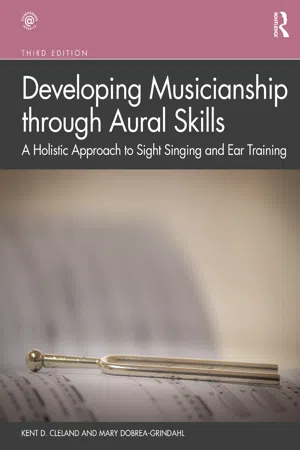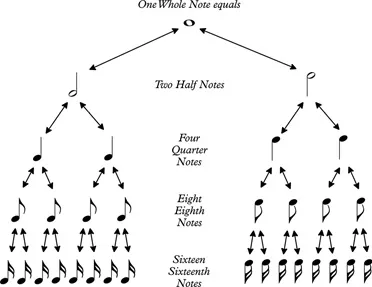
Developing Musicianship through Aural Skills
A Holistic Approach to Sight Singing and Ear Training
- 488 pages
- English
- ePUB (mobile friendly)
- Available on iOS & Android
Developing Musicianship through Aural Skills
A Holistic Approach to Sight Singing and Ear Training
About this book
Developing Musicianship through Aural Skills, Third Edition, is a comprehensive method for learning to hear, sing, understand, and use the foundations of music as part of an integrated curriculum, incorporating both sight singing and ear training in one volume. Under the umbrella of musicianship, this textbook guides students to "hear what they see, and see what they hear," with a trained, discerning ear on both a musical and an aesthetic level.
Key features of this new edition include:
- Revised selection of musical examples, with added new examples including more excerpts from the literature, more part music, and examples at a wider range of levels, from easy to challenging
- New instructional material on dictation, phrase structure, hearing cadences, and reading lead sheets and Nashville number charts
- An updated website that now includes a comprehensive Teacher's Guide with sample lesson plans, supplemental assignments, and test banks; instructional videos; and enhanced dictation exercises.
The text reinforces both musicianship and theory in a systematic method, and its holistic approach provides students the skills necessary to incorporate professionalism, creativity, confidence, and performance preparation in their music education. Over 1,600 musical examples represent a wide range of musical styles and genres, including classical, jazz, musical theatre, popular, and folk music. The third edition of Developing Musicianship through Aural Skills provides a strong foundation for undergraduate music students and answers the need for combining skills in a more holistic, integrated music theory core.
Frequently asked questions
- Essential is ideal for learners and professionals who enjoy exploring a wide range of subjects. Access the Essential Library with 800,000+ trusted titles and best-sellers across business, personal growth, and the humanities. Includes unlimited reading time and Standard Read Aloud voice.
- Complete: Perfect for advanced learners and researchers needing full, unrestricted access. Unlock 1.4M+ books across hundreds of subjects, including academic and specialized titles. The Complete Plan also includes advanced features like Premium Read Aloud and Research Assistant.
Please note we cannot support devices running on iOS 13 and Android 7 or earlier. Learn more about using the app.
Information
Module 1
Simple Meters
Module 1a: Simple Beats and Their First Division and Multiple Note Values

Simple Beats

Table of contents
- Cover
- Half Title
- Title
- Copyright
- Dedication
- Contents
- Preface
- The Method
- Syllable Systems
- Reading in Clefs
- Module 1: Simple Meters
- Module 2: Major and Minor Scales and Scale Degrees
- Module 3: Improvisation
- Module 4: Compound Meters
- Module 5: Intervals
- Module 6: Triads
- Module 7: Seventh Chords
- Module 8: Common Diatonic Harmonic Progressions
- Module 9: Irregular Division and Syncopation
- Module 10: Non-modulating Chromaticism
- Module 11: Modulation
- Module 12: Changing Meter, Polyrhythm, and Asymmetric Meters
- Module 13: Other Tonally Derived Scales
- Module 14: Post-tonal Music
- Appendices
- Index of Literature Examples
- Credits